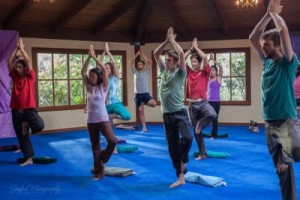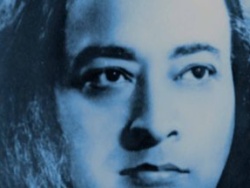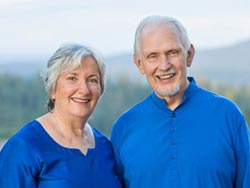A new type of yoga, Ananda Yoga, is highlighted in Finding Happiness when Juliet discovers a spiritual form of yoga for healing and transformation in body, mind, and soul. She has a private yoga session with Gyandev McCord, the author of Spiritual Yoga: Awakening to Higher Awareness.
Gyandev is a co-founder of the Yoga Alliance and director of Ananda Yoga, he is a writer, lecturer, travel host, and minister.
Q: You’ve taught Ananda Yoga for thirty years. How did you get started teaching?
Gyandev: I had been meditating for a number of years, and I took a hatha yoga class on a whim. The class was very physically oriented, which was perfect for me, since I was a physically active person. I loved it – until I realized it was detracting from my meditation. I would come out of the classes feeling mentally exhausted and strung-out.
I loved how my body felt, but my mind wasn’t liking it so much. It was only when I discovered Ananda Yoga that I realized there was an approach to the yoga postures that completely supported my meditation.
I took the Ananda Yoga teacher training course without any intention of teaching, simply to understand yoga better. When the course ended I dusted off my hands, said thank you very much, and imagined it was the closest brush with teaching I would ever have. But when the main Ananda Yoga teacher in the Bay Area left, I was asked to take her place.
I moved to Ananda Village and continued to teach, and when the position of director of Ananda Yoga became vacant, my name got filled in, and it’s been filled in ever since. (laughs)
Q: What is it about Ananda Yoga that helped your meditation practice?
Answer: Ananda Yoga brings together three key dimensions of our being – body, energy, and mind-spirit. The ancient philosophy of yoga maps out these connections in a wonderful way that tends to get lost if we view yoga as just a set of physical exercises.
Ananda Yoga focuses very specifically on the mental-spiritual-heart connections. It says, “If the positions of the body can make us feel better, how can we enhance the effect?”
Many people walk out of their first yoga posture class feeling, “Wow, this is great. Something’s really going on here. I feel so different.” They return in search of that experience, but the best results can appear to be random, outside our conscious control. Ananda Yoga asks “How can we participate in the process, and get the results of calm vitality, bliss, and uplifted energy as efficiently and reliably as possible?”
Ananda Yoga addresses how those three dimensions of our being – physical, energetic, interior – link up, and how we can supercharge the process of opening our awareness and finding joy.
The physical postures awaken energy, and with increased energy, it tends to uplift our thoughts and feelings. It’s a down-to-earth process that happens every day. You get good news, and your energy soars, and you straighten your posture and smile. When you get bad news, your energy crashes and you slump and frown. We experience these movements of energy all the time.
Ananda Yoga works from the other direction. It says, “Let’s use physical postures to influence our energy and mind.” It says “Here’s how we can we insert ourselves in the process and use our energy to feel as expansive and fulfilled as possible.”
Q: Is Ananda Yoga concerned with the search for happiness?
Answer: Very much so. Ananda means “joy.” It wouldn’t be called Ananda Yoga it weren’t concerned with happiness.
The sages of all ages tell us that the highest octave of our awareness is bliss. It’s who we are, and it’s what we’re aiming for, consciously or not. We can reap many benefits from yoga – calmness, peace of mind, more energy, and so on. But Ananda Yoga looks at how all of these feed into our search for ever-increasing happiness.
Q: If we aren’t following a spiritual path, can Ananda Yoga help us in more mundane ways – to find relief from stress, have better concentration, and be more poised in challenging circumstances?
Answer: It can. But put it this way, without some form of meditation, it’s like cooking a meal without eating it. To get the benefits of yoga at the deepest, most enduring level, you need to have a meditation practice. Without meditation, yoga isn’t all it could be. Even a small amount of meditation makes a big difference.
Q: If you’re working with energy, does it mean that Ananda Yoga is less concerned with thinking than with feeling?
Answer: It’s experiential. You don’t turn off the thinking process, but you direct the mind’s energy away from restless thoughts and worries, toward a more heart-oriented awareness that’s very uplifting and healing. It’s not emotion, it’s calm perception.
Q: Does it help people feel they’re a better person?
Answer: Absolutely. But they don’t feel like a different person, they feel they’ve suddenly got access to a part of themselves that they weren’t aware of before. It’s a lovely feeling, because you see that you’re more than you thought you were. When people begin to see that they’ve got more happiness than they knew, it’s a very good experience.
Q: You’re accessing a part of you that you didn’t know was there?
Answer: Perhaps you hoped it was there, but you didn’t know how to access it. I think everybody knows there’s something special about them. They can’t put their finger on it, but they sense there’s something special about each soul. There’s a big difference when you start to experience it.
We all want to experience the happiness that’s hidden inside us. The whole of Ananda Yoga is engaged with helping us do that. Not everyone needs to be looking for these higher spiritual benefits. But it’s the ultimate goal. People usually begin with something more basic, like finding peace of mind, relieving stress, having more energy, and reconnecting with a body that’s been neglected.
Those are definite benefits of the practice, and they come quickly. People don’t have to practice for years, or even months or weeks, to get them. But the more you get, the more you realize there’s even more, and it tends to draw you deeper in the process.
Q: It sounds like it’s been fulfilling for you.
Answer: It has. It takes extreme circumstances for me to miss my daily practice. I would say it’s the most important part of my life. I wish everybody had this mechanism for improving the quality of their lives.
Q: If it’s fulfilling for people, is Ananda Yoga growing?
Answer: It is. The popularity of yoga, so far, has been based on the postures. Most classes are still oriented toward the body. But increasing numbers of teachers are emphasizing the spiritual, emotional, and mental benefits.
I spoke recently with some friends from Los Angeles. They were saying how, even in LA, the Mecca of the body, people are wanting something more from yoga. They’re wanting something more than the physical.
If it’s happening in LA, we can pretty much expect that it’s happening elsewhere, or it soon will be. For some, a better body is all they’ll ever want, and that’s fine. They can stay with the physical and enjoy it. But for many, a little practice opens up their awareness of a joy inside, and it stimulates a desire for more. We’ve come to a time when people are looking for joy.
When I started teaching in 1983, not many people were looking for joy. It was harder to communicate the subtle aspects of Ananda Yoga – I would talk about energy, and I’d get lots of blank looks. But everybody seems to have a feel for energy now, and hardly anybody is freaked when I talk about it. It’s easier to communicate Ananda Yoga than it used to be. People are ready for it now.
—
Gyandev’s light-hearted humility shines through his classes, putting students at ease. Follow this link to read a selection of his articles, purchase instructional videos and CDs, and view his teaching schedule. You can also watch a free video, Ananda Yoga for Busy People, on YouTube, with Gyandev and Lisa Powers.










